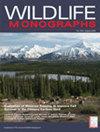Variation in mallard vital rates in Canadian Aspen Parklands: The Prairie Habitat Joint Venture assessment Variación en las estadísticas vitales del Ánade real en las zonas verdes de Aspen en Canadá: Evaluación del Proyecto Conjunto Hábitat de la Pradera Variation des indices vitaux du Canard colvert dans les Forêts-Parcs à trembles Canadiennes: Évaluation du plan Conjoint des Habitats des Prairies
Abstract
The Prairie Habitat Joint Venture (PHJV) delivers conservation programs for the Canadian portion of the Prairie Pothole Region under the North American Waterfowl Management Plan. The PHJV Assessment was designed to evaluate biological assumptions and effectiveness of PHJV conservation activities. Our objectives were to 1) test whether waterfowl reproductive success increased in response to the full suite of PHJV habitat treatments, and 2) quantify the relationships between mallard (Anas platyrhynchos) vital rates and landscape variables. We focused on examining the association of mallard vital rates with covariates measured at the study-area scale. We collected information on vital rates from 3,214 radio-marked female mallards at 27 study areas mainly throughout the Aspen Parkland ecoregion of Manitoba, Saskatchewan, and Alberta in 1993–2000. We used a modeling framework and information-theoretic techniques to test hypotheses about putative effects of environmental covariates on adult female and duckling survival, nesting effort, and nest survival. Additionally, we constructed a stage-based matrix projection model of mallard population growth (λ) to estimate the sensitivities of population growth rates to variation in vital rates. Nest survival was positively related to the amount of herbaceous vegetation on study areas and total precipitation for the 12 months prior to nesting. Nesting effort was positively related to wetland inundation in July. Duckling survival was positively related to the proportion of seasonal wetlands holding water in July and negatively related to the number of days in June and July when the minimum air temperature dropped below 10° C. Adult female survival rate was positively related to both the proportions of grassland and wetland habitats measured at the study-area scale (65 km2), though these factors interacted such that the positive relationship with proportion of wetlands was strongest on study sites with high proportions of grassland. The stage-based projection model constructed using mean vital rates indicated that populations were declining (mean λ = 0.95, median λ = 0.98, 5th percentile = 0.68, 95th percentile = 1.38). Variance-stabilized sensitivities indicated that population growth was most responsive to variation in vital rates for after-second-year birds and that nest survival was the single vital rate to which populations were most sensitive. A prospective simulation revealed that, as expected, sensitivity to nest survival is likely to decrease at higher levels of nest survival. Despite evidence that nest survival was higher in PHJV habitat treatments than surrounding habitats, our a priori PHJV treatment index was unrelated to mallard vital rates estimated at the 65-km2 scale. Although mallard populations were affected by several weather variables and land uses, efforts to increase populations should focus on improving nest survival rates, which currently are below approximately 30%. © 2014 The Wildlife Society.

 求助内容:
求助内容: 应助结果提醒方式:
应助结果提醒方式:


